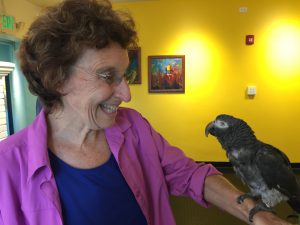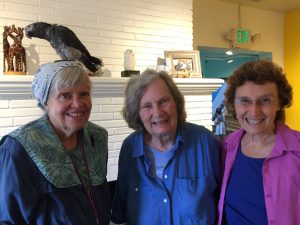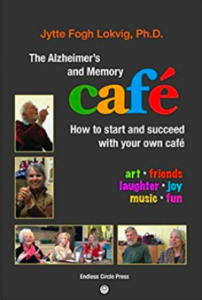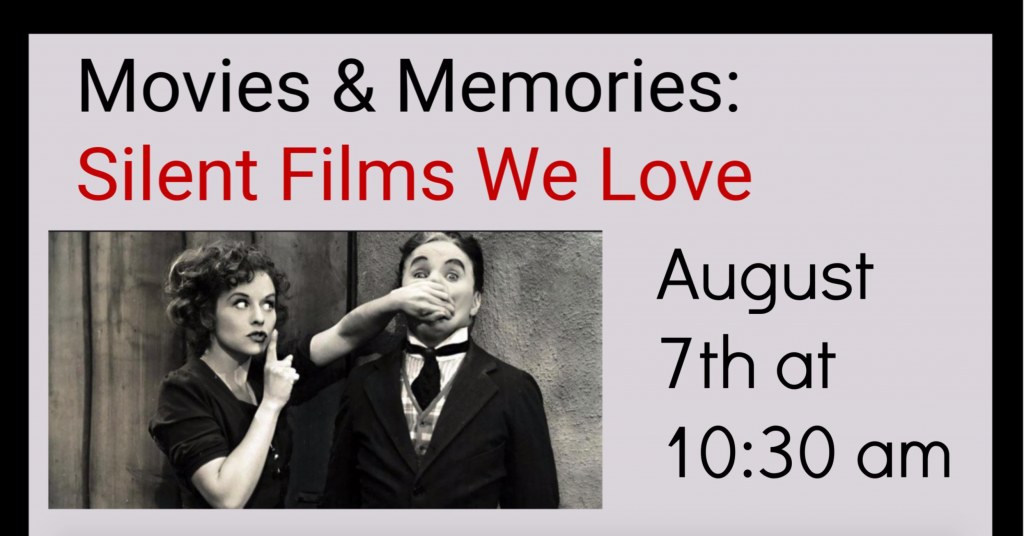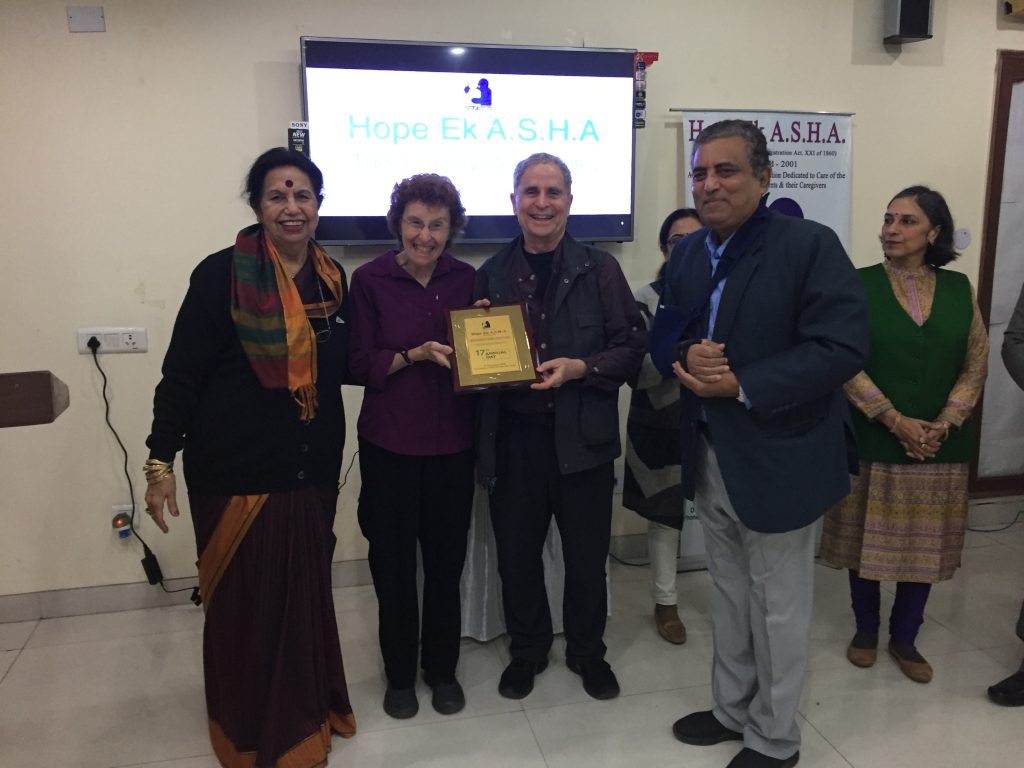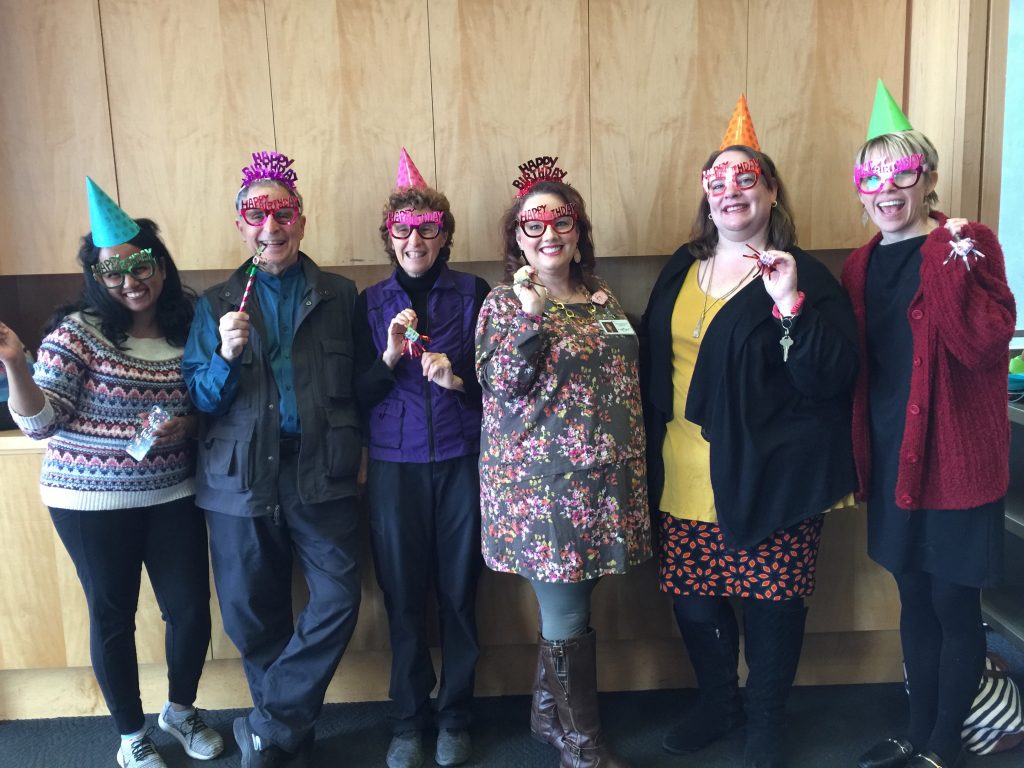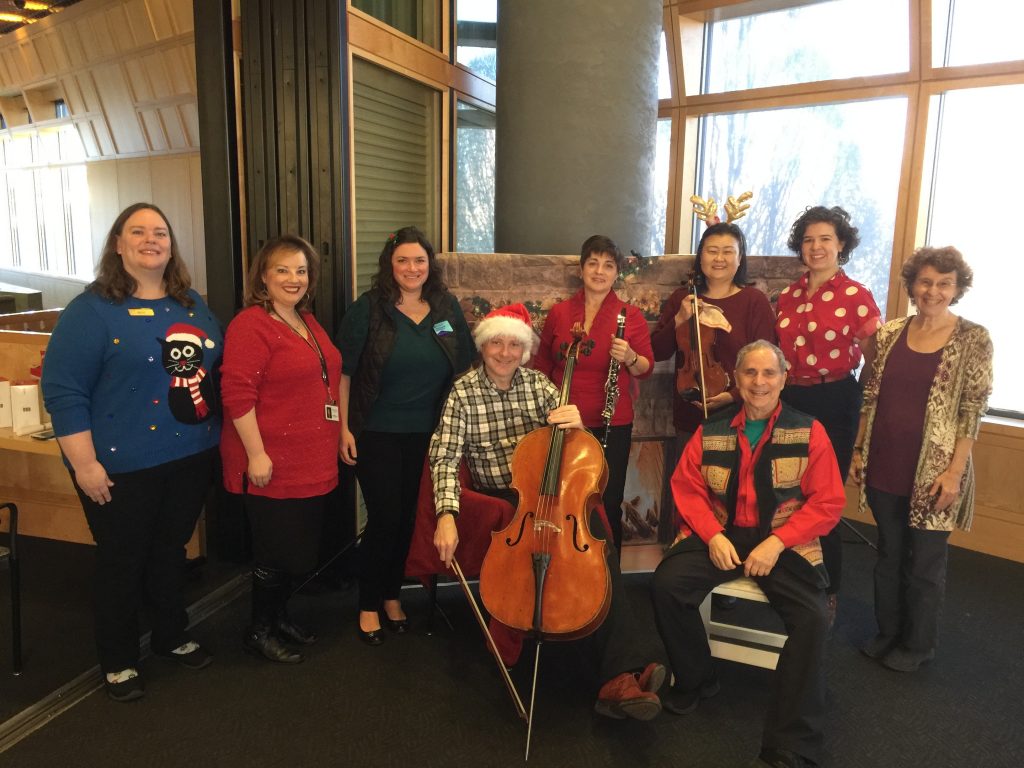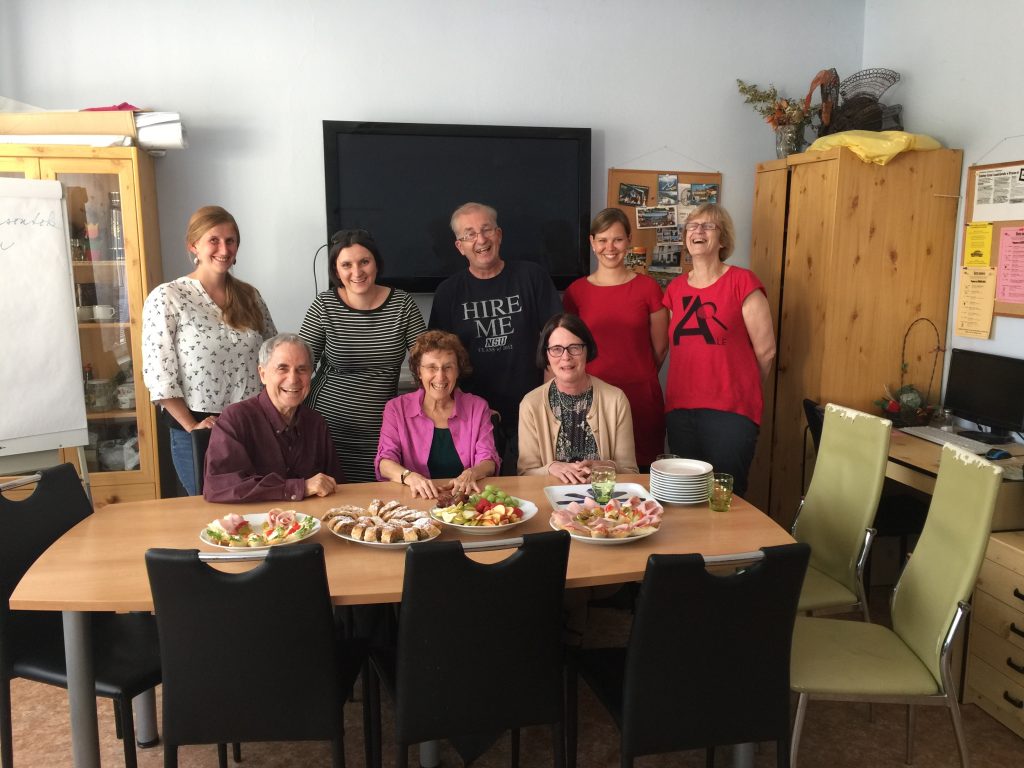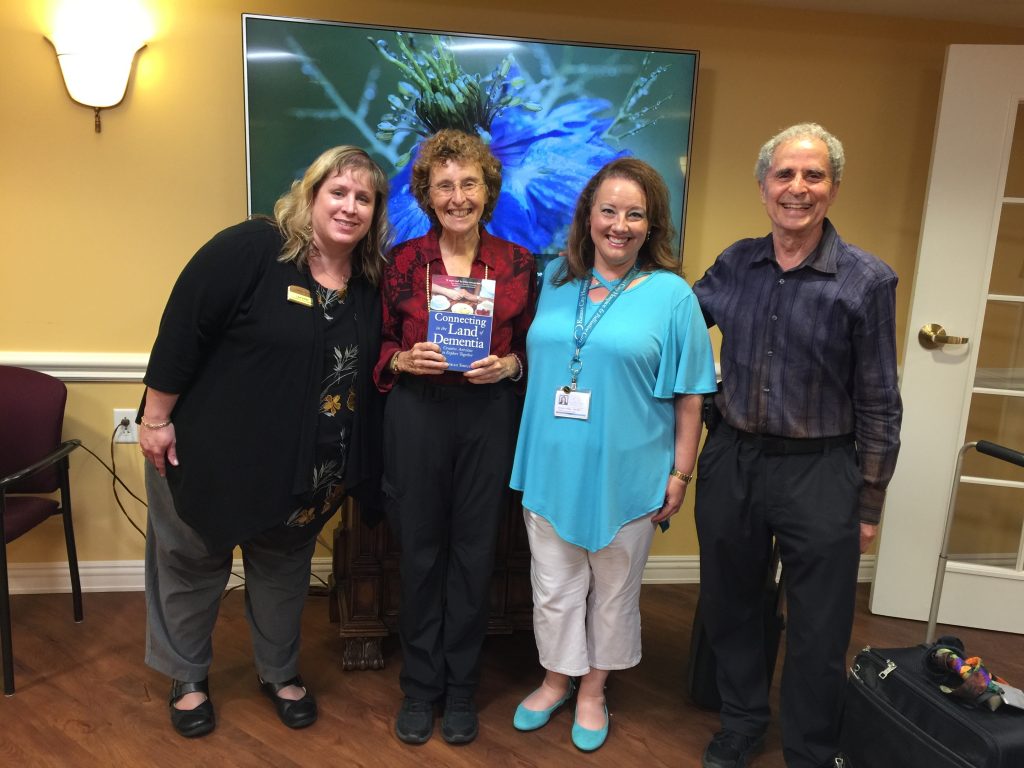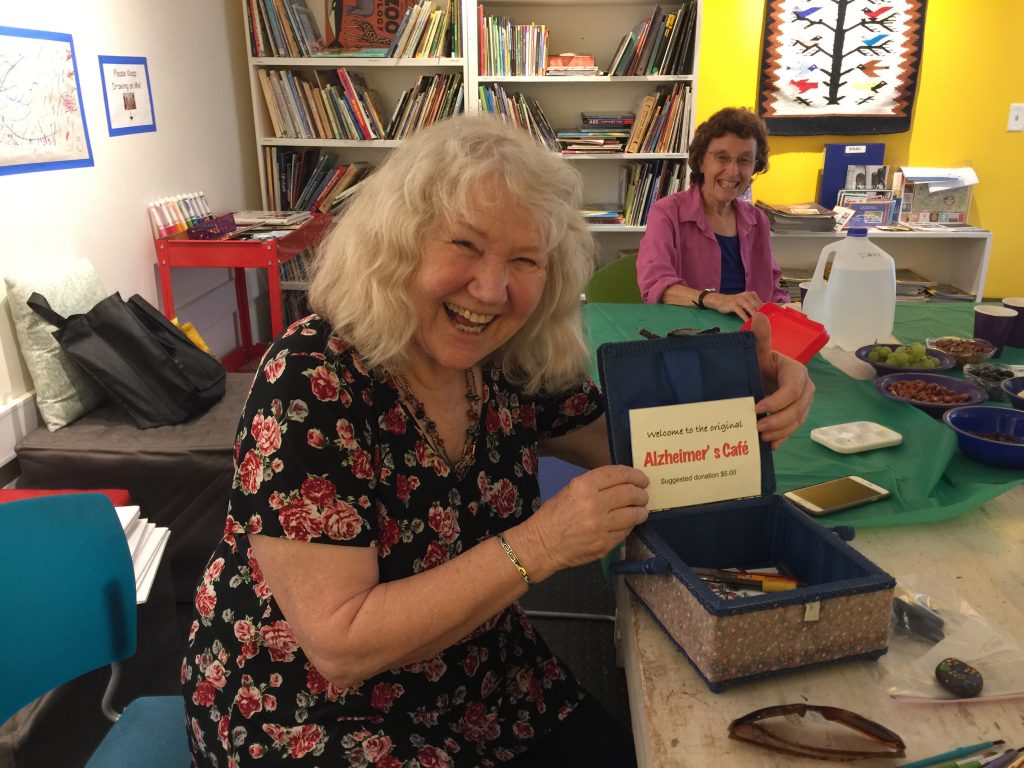Activities
Upcoming KC Dementia Friendly Events
Please join us for these upcoming KC Dementia Friendly events, specially created for people who are living with dementia and their family, friends, and care partners.
All are welcome.
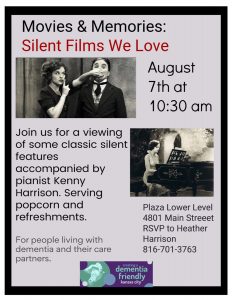
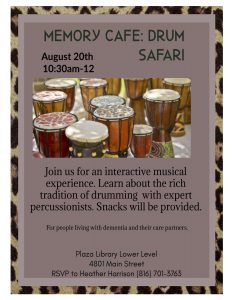
Click to view informative and inspiring short videos on our YouTube channel
Deborah Shouse is the author of Connecting in the Land of Dementia: Creative Activities to Explore Together and Love in the Land of Dementia: Finding Hope in the Caregiver’s Journey.
Let’s have a ball together
We hope you can join us for one or both of these fascinating free events.
Please share with those who might benefit:
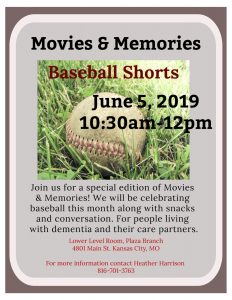

Coming Together to Ignite Hope: Working with Dr. Chawla in New Delhi, India
Our Uber driver in New Delhi was a turbaned Sikh with a long gray beard. A sign hanging from the rear view mirror proclaimed, “This car respects women.” He deftly drove us through the city, navigating the melee wherein four lanes of cars compete in a two-lane space. Inside the NGO, Hope Ek A.S.H.A., the receptionist led us into Dr. Chawla’s office. Dr. Chawla has a rich voice and a magnetic presence. She is the catalyst for this center for caregivers, creating the service because of her own experience with her mother and Alzheimer’s. We were coming together to ignite hope.
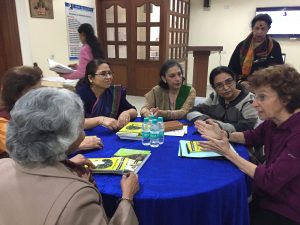
“We know how hard it is for the caregivers,” she says. She and her team help caregivers throughout New Delhi and indeed, throughout the world, educating them, visiting with them and their loved ones who are living with dementia, facilitating support groups, sharing stories and ideas, offering respite and financial support as possible.
For this event, she has gathered a group of doctors, caregivers, support staff, and more. First, some of her team show us activities they do with clients who are living with dementia. These include chanting, deep breathing, gentle stretching, tapping (EFT- Emotional Freedom Techniques), and a lovely heart opening exercise that affirms “We are healthy, we are happy.” They show us painting and games that strengthen memory.
Join us for these interesting exercises:
Then a caregiver from Mumbai Skypes in. Her voice is sad and her face is drawn and pale. She wipes at her eyes as she discusses her issues with her father. Instantly, one of our caregivers steps forward to offer advice. I share ideas with her as well. Then Dr. Sahi, leader of the New Delhi Laughter Academy, guides us in laughter exercises. Within minutes, we are all laughing, even our friend from Mumbai. When the session ends, the worn and weary caregiver has been transformed into an energetic and renewed woman, one who believes there is hope.
That’s is one of the reasons we all came together: our mutual hope and our belief that everyone needs support and a sense of community and purpose.
Experience our New Delhi caregiver’s event by watching this video:
Deborah Shouse is the author of Connecting in the Land of Dementia: Creative Activities to Explore Together and Love in the Land of Dementia: Finding Hope in the Caregiver’s Journey.
Rock Around the Library: Celebrating a Year of KC Memory Cafes
No one can sit still. Not when Little Richard, The Archies, or Dion are singing. It’s a Rock Around the Library: Celebrating a Year of the KC Memory Cafes. We are one-year-old this March and we’re celebrating with Musical Bingo by Carrieoke Productions. We’ve enjoyed ice cream and cake and we’re ready to roll, rock and roll, that is.
At the first note, one of our guest says, “Sugar, Sugar.” She’s right and a small group of us sings the literally saccharine 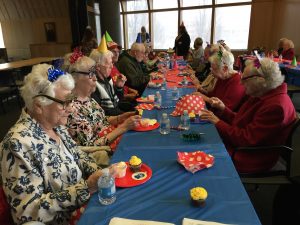 lyrics, “Sugar, ahh honey, honey, you are my candy girl…”
lyrics, “Sugar, ahh honey, honey, you are my candy girl…”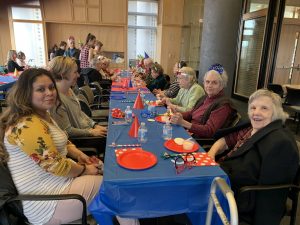
Within moments, all the care partners are dancing. We’re all helping each other find the songs on our Bingo sheets. We’re singing along when we know the lyrics and humming along when we don’t. We’re laughing.
When Carrie plays the Beach Boys’ tune, I Get Around, one guest says, “I wish I could get around.” Another chimes in, “Me too!”
For an hour, we Twist and Shout, warble Do You Want to Dance?, warn our neighbors not to “step on my Blue Suede Shoes,” and shake our heads over Run Around Sue. Those who win at musical bingo, and there are many of them, get to select a prize. 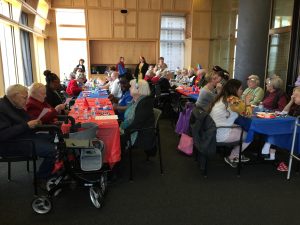
“It’s wonderful to see people blooming,” one care professional says.
And it’s equally wonderful to see the caregivers laughing, joking, dancing, encouraging, sharing, and helping us create This Magic Moment.
Click here to join the party:
Don’t miss our Magic Moment in April. The Kansas City Zoo is bringing some exotic and personable animals on April 16th.
Please join us at 10:30 on the lower level of the Plaza Library. Come early. Please share this information with anyone who might benefit.
Deborah Shouse is the author of Connecting in the Land of Dementia: Creative Activities to Explore Together and Love in the Land of Dementia: Finding Hope in the Caregiver’s Journey.
Art Invites Conversation
Teri Miller, with the Alzheimer’s Association Houston & Southeast Texas Chapter, has witnessed the power of how art invites conversation. As the Early Stage Program Manager, Teri collaborates with a variety of Houston’s arts and civic organizations.
“Going to cultural activities offers people a sense of normalcy and gives them a date to put on their calendars,” Teri says. “When they go with friends or care partners, they have an experience to discuss. Even people who say, ‘Oh, I don’t care for museums,’ usually have a great time.”
Sam is an example of someone who was surprised to enjoy the art gallery.
He attended one of Teri’s early stage support groups. His wife, who cared for him at home, went to the care partner’s group. Teri formed a partnership with the Houston Museum of Fine Arts and invited her early stage group to experience a tour. When he heard the invitation, Sam rolled his eyes and said, “I’ve never been to a museum and I’m not about to start now.”
But the next week, Sam signed up for the tour.
“What made you change your mind?” Teri asked.
“My wife really wanted to go. She does so much for me, I figured I’d do something for her.”
Teri expected Sam to sit back silently, arms folded over his chest, as the docent asked, “What does this painting make you think of? Has anyone ever been in a similar setting?” But to Teri’s surprise, Sam had opinions on each of the three pieces they discussed.
Sam told Teri, “At first, I didn’t want to go because I was worried I wouldn’t have anything meaningful to contribute. But I guess you don’t have to know anything about art to enjoy the museum.”
He and his wife talked about the experience all the way home. Discussing the paintings opened up chances to reminisce and connect. Plus the experience gave them something interesting to share with their grown children and visiting neighbors.
Like many art partnerships around the country, Teri was inspired by MOMA’s Meet Me art program for people living with dementia. The Houston museum benefitted from MOMA coming to train their docents. The program offers comprehensive guidelines for visiting a museum or viewing art at home.
Creative Sparks:
Many art galleries and museums offer special tours and events for people living with dementia. If you’re lucky enough to have such a tour available, take advantage of it.
To design your own museum tour:
- Think of a museum your partner likes. If feasible, buy postcards of some of their art or visit their on-line gallery together and ask your partner which pieces he prefers. That way, you can tailor the visit to his taste.
- Choose one or two rooms that feature his preferred art. Make sure one room has a place to sit.
- Use the paintings and sculptures as a catalyst for conversation. Ask open-ended questions, discussing the colors, people, and objects you both notice.
- If the museum has a restaurant or tearoom, treat yourselves to something delicious.
- Enjoy the sense of connection that comes from discussing art; there are no right or wrong answers, just interesting observations.
- To fashion a viewing experience at home:
- Select art books from the library or use your own personal collection.
- Choose works that portray emotion, tell a story or align with your partner’s background or interests.
- Ask open-ended questions that invite conversation, such as, “What does this make you think of?” and “What do you notice in this picture?” Have fun imagining what the people in the painting are thinking. Imagine their professions and whether they’re happy.
This is an excerpt from Connecting in the Land of Dementia: Creative Activities to Explore Together. Deborah also wrote Love in the Land of Dementia: Finding Hope in the Caregiver’s Journey.
Santa and the Symphony Visit the KC Memory Cafe
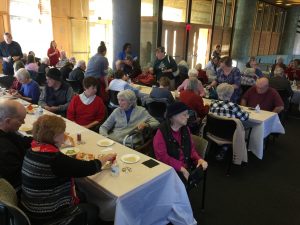 At our December Memory Cafe, Santa had an amazing pre-show- warm-up band: a trio from the Kansas City Symphony. Their renditions of familiar holiday tunes were musical works of art, filled with melodic flourishes and surprises. Our guests listened avidly. When Stephanie Brimhall, the Symphony’s Education Manager, led us in a singalong, everyone raised their voices and sang with heart and gusto. As our attendees finished decorating Christmas cookies with colorful icings, bright sprinkles, and little chunks of peppermint, we heard a jingling of bells and a booming, “Ho Ho Ho.” Santa had arrived, with a sack of treats.
At our December Memory Cafe, Santa had an amazing pre-show- warm-up band: a trio from the Kansas City Symphony. Their renditions of familiar holiday tunes were musical works of art, filled with melodic flourishes and surprises. Our guests listened avidly. When Stephanie Brimhall, the Symphony’s Education Manager, led us in a singalong, everyone raised their voices and sang with heart and gusto. As our attendees finished decorating Christmas cookies with colorful icings, bright sprinkles, and little chunks of peppermint, we heard a jingling of bells and a booming, “Ho Ho Ho.” Santa had arrived, with a sack of treats.
“How many of you have been good?” Santa asked and most of us raised our hands. Santa made the rounds, passing out sweet treats, courtesy of Russell Stover Chocolates, and wishing everyone a merry holiday. 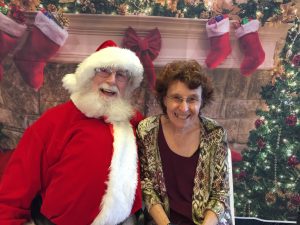 Then he settled into a comfortable chair beside the backdrop of a scenic hearth. We all lined up to sit beside him and have our photos taken with the Great Claus. Santa warmly welcomed each person and everyone was just thrilled to be near him — and even more thrilled when Jennifer Walker’s remarkable little printer produced a wonderful photographic memento of the event.
Then he settled into a comfortable chair beside the backdrop of a scenic hearth. We all lined up to sit beside him and have our photos taken with the Great Claus. Santa warmly welcomed each person and everyone was just thrilled to be near him — and even more thrilled when Jennifer Walker’s remarkable little printer produced a wonderful photographic memento of the event.
At the end, Santa summed up the holiday spirit by sharing this message: “Peace for the world and good will for all people.”
We hope we can all continue this spirit of hope, sharing, and generosity throughout the new year.
Capture the cafe spirit for yourself by clicking on this short video:
Deborah Shouse is the author of Connecting in the Land of Dementia: Creative Activities to Explore Together and Love in the Land of Dementia: Finding Hope in the Caregiver’s Journey.
An Old-Fashioned Holiday
This old-fashioned holiday story from Love in the Land of Dementia: Finding Hope in the Caregiver’s Journey celebrates the spiritual aspects of living with dementia.
When I walk through the doors of the nursing home, I find my mother in her wheelchair, right in front of the medication cart, right behind the central nursing station, where nurses, delivery people, staff and family members congregate. Mom is bent over, her baby doll lying across her lap. When I walk up to her, I ratchet up my energy and widen my smile. I am preparing to clown her into a reaction.
Later my father will ask if I think she recognized me.
“No,” I will have to tell him. “She did not recognize me. But she did smile.”
The smile is important.
My hand waving and head bobbing does its work: Mom does smile, and I can tell she is in her own current version of a good mood.
“Music in the dining room,” the activity board reads, so I wheel her in that direction. An elderly man with a red and white trimmed Santa hat passes us in the hallway.
“Look Mom, there’s Santa,” I tell her.
Having been brought up Jewish, Mom never was all that enthralled with the Claus mythology and she has not changed.
A white-haired woman is in the dining room, busily setting up for the music program. Several patients are already gathered. The woman takes out a microphone, a boom box, an illuminated plastic snowman, and a small silver bell. I continue wheeling Mom down the far corridor, liking the sense of companionship I have from this movement.
As we stroll, a nurse carrying a plate of lettuce walks past us.
“She must have been a good mother,” she says, nodding at the way Mom is holding the baby. “She must still be a good mother.”
“She is,” I say.
I have never really said to my mom, “You were a good mother.”
Now I realize she was.
I can see that Mom is enjoying the ride. She loved movement when she was younger and was far more adventuresome than Dad when it came to airplanes, ski lifts, fast cars, and speedy boats. For her, biting breeze across the face was thrilling, not threatening. Until she became a mother, that is. Then she abandoned her pleasure in the heights and speed and concentrated on making sure we were slow, safe, and centered.
We roll back into the dining room just as the show is ready to start. The singer, Thelda, kicks off her shoes and presses play on the boom box. Above the cheerful sound track, she sings Jingle Bells. She dances across the room with the remnants of ballroom steps. She stops in front of Mom and sings right to her. She gets on her knees, so she can look into Mom’s eyes, and keeps singing. Mom notices her and smiles a little.
Thelda moves on, singing to each of the patients gathered around, so intent on making a connection that she often forgets the words.
“Is it all right for your Mom to come to Christmas holiday events?” the activity director had asked me, when Mom moved from the memory care into the skilled care portion of the nursing home.
“Yes, I’d like her to go to any activities. She likes the extra energy.”
I think Mom would approve of my decision, even though she has never celebrated Christmas. Growing up, her immigrant mother held on to the Jewish spirit of her home, kneading dough for Friday evening challah, observing each holiday and prayer period in her own way. Some orthodox women followed the religious law that commanded a small piece of the dough be burned as an offering to God. My grandmother was poor; she did not believe in burning good food, regardless of tradition. So she sacrificed a portion of the dough to her youngest daughter, my mother Fran. She created a “bread tail,” leftover dough that she smeared with butter and sprinkled with sugar and baked. When Mom used to talk about her mother, she always mentioned this special treat.
Even when I was growing up, and we were the only Jewish family in our neighborhood, my mother still did not sing Christmas songs. She did not willingly go to Christmas parties. She let the holiday rush by her, like a large train, whooshing past, ruffling her hair and leaving her behind.
Now, I am singing Christmas carols to my Mom for the first time. She is smiling, though really not at me. But I am sitting beside her while she is smiling and that makes me happy. She has moved beyond the place where the religions are different, beyond the place where she wants to separate the dough and make a sacrifice for tradition. Her new tradition is anyone who can make her smile.
With each song, from White Christmas, to Silver Bells, to Frosty the Snowman, Thelda moves back to Mom, tapping her, nudging her, shaking a bell almost in her face, acting sillier and sillier. Each time, Mom lifts her head and widens her mouth for a second.
For her finale, Thelda puts on a big red nose and sings Rudolph. When she dances in front of Mom with that nose, Mom laughs. For several minutes, Mom stays fixated on the scarlet nose, her face a miracle in pure enjoyment. I laugh too, so delighted to see Mom engaged and absorbed. Then, Thelda dances away and Mom’s face glazes back over.
Two weeks from now, I will bring a menorah and candles into my mother’s room. My father and I will have a short Chanukah ceremony with Mom. She will pick at the shiny paper covering the Chanukah gelt (chocolate candy disguised as money). She will slump over in her chair. But she will come back to life when she sees me, her only daughter, wearing a big red nose as I light the menorah.
Deborah Shouse is the author of Connecting in the Land of Dementia: Creative Activities to Explore Together and Love in the Land of Dementia: Finding Hope in the Caregiver’s Journey.
Czech Mates in Dementia Care: Laughter Yoga in Prague
The table was spread with an array of Czech delicacies: apple strudel, special sandwiches with flowers of ham atop fresh baguettes, a bountiful tray of strawberries, grapes, and apple slices. 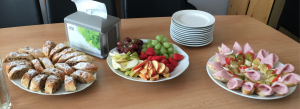
“This is the way we welcome people here in Prague,” said Lucie Hajkova, social worker and coordinator of respite care for the Czech Alzheimer’s Society.
Ron and I were visiting the Gerontological Centre and the Czech Alzheimer’s Society, which are both housed in the same building. The two organizations work together to offer clients everything they need, from psychological counseling, to memory testing, to social work services, to healthcare. We came to learn and to present a laughter yoga session.
We gathered with staff members around the table to learn about the center, which was started in 1997 by Iva  Holmerova, MD. along with Hana Janeckova, PhD. Hana was putting together training materials for caregivers when she was contacted by Alzheimer’s Disease International. They wanted to know more about her work and they invited her to an international conference in Jerusalem. That conference was a turning point. Hana left it inspired and determined to help Czech families that were dealing with dementia. She contacted Iva and both saw the need to offer education, diagnosis, support, and care for people living with dementia and their families in the Czech Republic. Today, both centers are flourishing.
Holmerova, MD. along with Hana Janeckova, PhD. Hana was putting together training materials for caregivers when she was contacted by Alzheimer’s Disease International. They wanted to know more about her work and they invited her to an international conference in Jerusalem. That conference was a turning point. Hana left it inspired and determined to help Czech families that were dealing with dementia. She contacted Iva and both saw the need to offer education, diagnosis, support, and care for people living with dementia and their families in the Czech Republic. Today, both centers are flourishing.
We were impressed with the dementia services they offered, which included home care for people who need help with bathing, dressing, eating, exercise or more. The building holds a respite center. When families need renewal time, or when people living with dementia need extra care or healing time, they can stay in respite for up to a month. The Centre also hosts a day program that offers a variety of activities in a homey and comfortable setting,
Even more impressive than the Society’s services were its staff. Each had a passion for this work, a love for those who are living with dementia, and a compassion for their families.
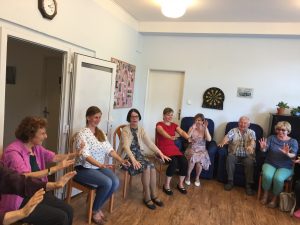
We had a wonderful time sharing a laughing session at the day center—our first international facilitation. We sat in a beautiful circle of people living with dementia, staff, family, and friends. We couldn’t have done it without our translator, Eliska, who captured the energy and essence of what we were saying. And once we all started laughing, we were beyond the constraints of language. Click here to experience a bit of laughter in Prague.
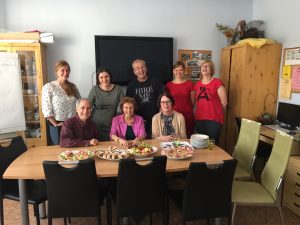
Photo Caption:
Eliska Brouckova, psychologist, consultant/advisor for people with dementia and their care givers
Martina Matlova, Director
Petr Veleta, PhD, dancer, dance therapist
Marketa Splichalova, psychologist, consultant/advisor for people with dementia and their care givers
Eva Jarolimova, PhD, psychologist, consultant for people with dementia and their care givers
Hana Janeckova, PhD, co- founder of the Czech Alzheimer Society, head of governing board of Czech Alzheimer Society, University teacher, researcher
Lucie Hajkova, social worker, coordinator of respite care in homes of people with dementia.
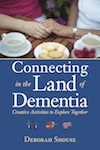
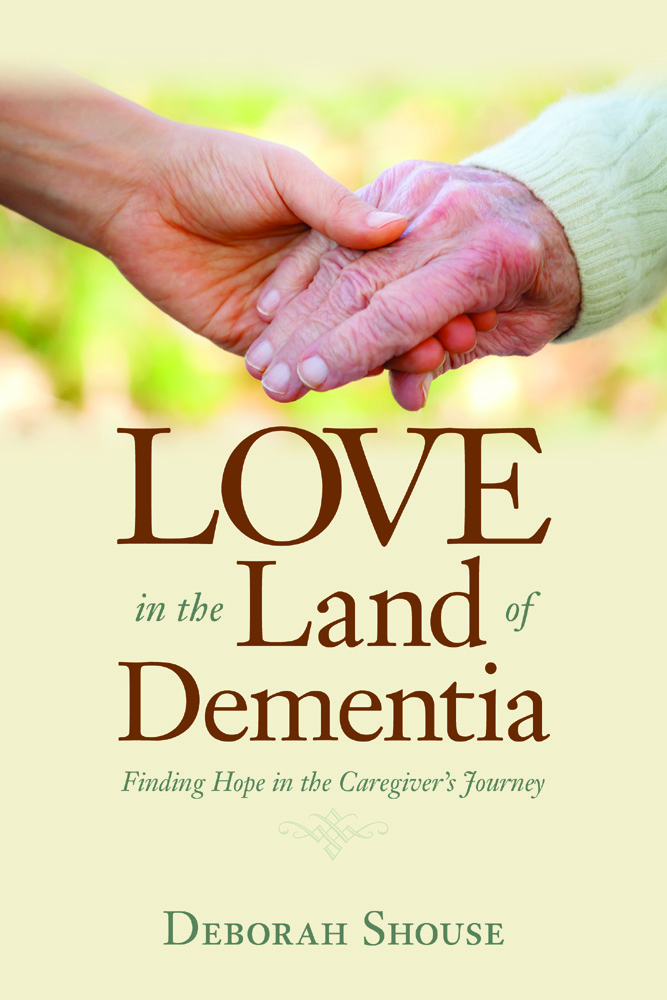
Celebrating Great Connectors Throughout the Dementia Journey: Music, Nature, and Laughter
When care partners gather and trade stories and ideas, there’s usually magic afoot. We felt that magic when we met with a group of family and professional care partners to celebrate great connectors throughout the dementia journey. We presented engaging ideas using music, nature, laughter and more.
Lisa Vetter, Director of Healthcare Sales & Marketing, Santa Marta Senior Living Community, invited us to speak at an event announcing the community’s new care partner support group. The group is led by Jennifer Walker, RN, BSN, Clinical Community Liaison, Kansas City Hospice & Palliative Care. Jennifer also facilitates the KC Memory Cafe and she is compassionate, informed, and smart. Most importantly, she has a fantastic sense of humor.
Ron and I shared ways to stay connected through singing and music, looking at works of art together, bringing nature indoors, and laughing. And our audience shared their experiences as well.
Here’s a story about nature that inspired us.
Marcie took her mom, who was living with dementia, on a fascinating monthly outing: they drove out into the country to look at the full moon. Her mother didn’t talk much anymore, but she loved seeing the night sky and gazing at the magnificent moon. One evening, as the moonlight spread over the car, Mom began singing, When the moon comes over the mountain. Marcie had never heard the song before and her eyes filled with tears at hearing her mom sing so strongly and clearly.
Here’s a story about the power of familiar music. Karen’s mom was a devout Catholic, living with dementia. Though there were many things she didn’t remember, including her daughter’s name, when she attended Sunday mass, she melodically sang every word of every hymn.
We loved sharing with this group of dedicated and compassionate care partners, who were all seeking ways to stay connected.
Here’s an extra tip from Connecting in the Land of Dementia: When you want to boost energy and lift spirits, add a splash of laughter into your life. Look at a clock and say, “We’re going to laugh for 30 seconds,” and start ha ha ha-ing. Or pretend you’re talking on the phone and hearing a hilarious joke. Or warble out the Ha Ha Chorus by singing the Happy Birthday song in “ha ha ha” syllables.


Dementia Friendly Cafes: Inviting Creativity and Connection
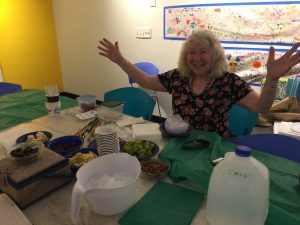 More than 10 years ago, Jytte Lokvig, PhD, was scanning the internet for additional information about dementia. On one of her Google searches she saw the words “Alzheimer’s Cafe” posted by Dr. Bere Miesen, who founded the first Alzheimer’s cafe in Leiden, the Netherlands in 1997. That phrase electrified her. She leapt out of her chair, much to the dismay of her cat, who was cozily sleeping across her feet, and declared, “I am going to make that happen in the U.S.!” She’d been working with people who were living with dementia in community settings for some years, orchestrating art, music, craft and other meaningful projects. But she felt something was missing. That something, she realized, was engagement in the community.
More than 10 years ago, Jytte Lokvig, PhD, was scanning the internet for additional information about dementia. On one of her Google searches she saw the words “Alzheimer’s Cafe” posted by Dr. Bere Miesen, who founded the first Alzheimer’s cafe in Leiden, the Netherlands in 1997. That phrase electrified her. She leapt out of her chair, much to the dismay of her cat, who was cozily sleeping across her feet, and declared, “I am going to make that happen in the U.S.!” She’d been working with people who were living with dementia in community settings for some years, orchestrating art, music, craft and other meaningful projects. But she felt something was missing. That something, she realized, was engagement in the community.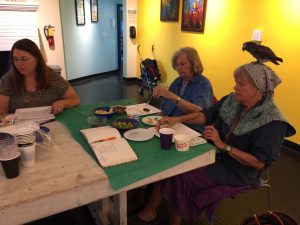 From that inspiration, Jytte created the original U.S. Alzheimer’s Cafe in Santa Fe, NM in 2008. Ten years later, there are more than 300 cafes in the US that invite creativity and connection through dementia friendly cafes.
From that inspiration, Jytte created the original U.S. Alzheimer’s Cafe in Santa Fe, NM in 2008. Ten years later, there are more than 300 cafes in the US that invite creativity and connection through dementia friendly cafes. 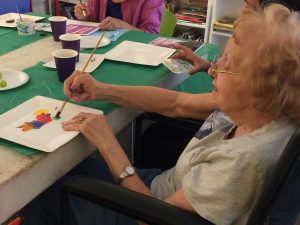 “Would you like a round plate of a square one?” she asked.
“Would you like a round plate of a square one?” she asked.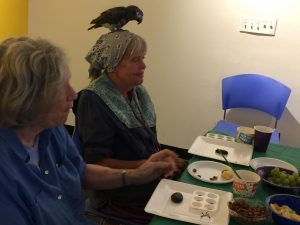
- Arrange a few snacks.
- Invite a guest or two, if you wish. This is an intergenerational project.
- Put a brightly colored plastic covering on the table.
- Squeeze some acrylic paint into a palette. Or use tempura or water colors.
- Offer a choice between two brushes.
- Offer a choice between two canvases: a cardboard paper plate, a river rock, paper, or other.
- Relax and let the painting unfold.
- If your loved ones need a little help, you can paint together. Or you can rest their hand on yours, while you paint to get them used to the movement of the brush.
- Appreciate the art by commenting on the color, the design, the shapes. Don’t ask them to identify the art: enjoy it as it is.
- Weave conversation into your time together.
